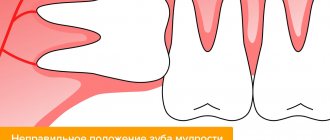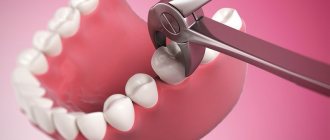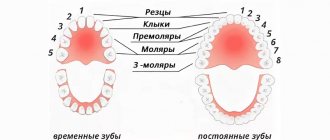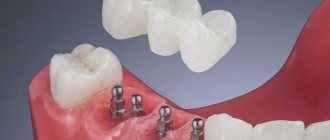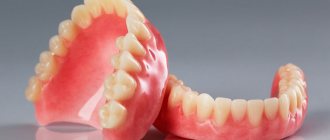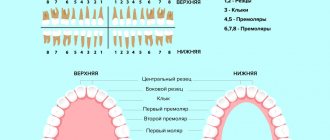Quite often, wisdom teeth cause problems to a person. They erupt at approximately the age of 20-25 years, when the dentition has already formed and in most cases their appearance is accompanied by complications. The extreme molars do not serve any useful function, so dentists often recommend that patients have them removed.
It should be understood that wisdom tooth extraction is a rather complicated procedure for both the doctor and the patient, especially the removal of molars on the lower jaw.
When you need to remove the bottom "eight". Indications
Wisdom teeth are distinguished by late eruption, which occurs at 20-30 years of age. During this period, the dental system is practically formed and the third molars often do not have enough space in the dentition. Eruption causes various complications and in most cases requires removal of the molar. In addition, in humans, with evolution, a decrease in the size of the jaws occurs, since, due to the nature of nutrition, the chewing load is constantly decreasing.
Most people do not take good hygienic care of their last teeth. They are located at the end of the dentition, and it is often technically impossible to clean them well. This leads to the accumulation of plaque, damage to the enamel by the carious process and its complications (pulpitis, periodontitis). Root canal treatment is very difficult due to difficult access. Therefore, eights must be removed in 90% of cases.
Removal of a fully erupted wisdom tooth
Removal of the lower wisdom tooth is indicated in the following cases:
- Excessive pressure on neighboring teeth, which can lead to their destruction;
- Injury to surrounding tissues;
- Constant biting of the mucous membrane of the cheek;
- Carious lesion that cannot be eliminated due to difficult access;
- Complications of caries: pulpitis, periodontitis, periostitis;
- Dystopia – location of the molar outside the dentition;
- A tooth that is a chronic source of infection;
- Formation of perihilar cysts, granulomas;
- Malocclusion and displacement of other teeth.
Removal of third molars
It is not always necessary to remove eights. If they have enough space in the jaw, they have normally located roots, grow vertically and erupt without complications, they can and should be preserved.
Indications for removal:
- complicated eruption, which is accompanied by swelling of the gums, severe or aching pain, inflammation, suppuration;
- incorrect location of dental roots, in which they interfere with the growth of neighboring teeth or gradually move or rotate them;
- incorrect position in the gum tissue - inclined or horizontal;
- absence of an antagonist tooth (for example, if the molars on the upper jaw have erupted correctly, but on the lower jaw they grow at an angle), violation of occlusion;
- small jaw size, in which there is no room left for the third molars, and they displace the entire dentition during eruption;
- inflammatory process in the root area, infectious, carious lesions, other dental diseases of third molars.
Removal of the lower impacted figure eight
A common complication is wisdom tooth retention, which is incomplete eruption. It can erupt above the gum as part of the crown or as one or two bumps. In this case, the second part of the crown will be covered with a gingival hood. With insufficient hygienic care, food accumulation, gum inflammation, and pericoronitis (inflammation of the hood) occur. In the case of pericoronitis, the dentist excises or cuts the gingival hood. But if the situation is constantly repeated and bothers you, then it is better to remove such a tooth. Chronic inflammation of the gums is a source of infection that spreads throughout the body and can provoke an exacerbation of other diseases.
What are the indications for tooth extraction?
Tooth extraction in dentistry is always a last resort procedure. Doctors make every effort to save the tooth or at least part of it, but in some cases extraction cannot be avoided. We are talking about many conditions.
- Chronic periodontitis, which is in the acute stage. As a rule, if the inflammatory process continues to recur, it is recommended to remove the tooth to prevent further spread of the infection.
- Very strong and deep carious lesion of the tooth.
- Odontogenic osteomyelitis, which usually develops as a complication of infection and is characterized by damage to bone tissue.
- The tooth constantly injures soft tissues. This happens especially often if the tooth is in an incorrect position. Permanent trauma is very dangerous, therefore, if the problem cannot be solved in another way, removal is recommended.
- Fracture of a tooth root or any other mechanical damage.
- Late stages of periodontitis, when the teeth begin to become very loose.
- An impacted tooth that cannot erupt and is covered on top by gum tissue. Most often this happens with wisdom teeth.
- Carrying out orthopedic treatment or prosthetics that cannot be done without removing one or more teeth.
Anesthesia
Before the operation, complete anesthesia of the required area of the jaw is carried out. The most commonly used is local anesthesia, which is carried out using a carpule syringe and an anesthetic. Anesthesia of the lower jaw occurs 8-10 minutes after the injection. The duration of the analgesic effect depends on the drug used and is 2-4 hours. The operation itself is completely painless, but after the anesthetic wears off, the patient begins to feel pain. Therefore, after the procedure, the specialist gives prescriptions about the need to use medications (painkillers, anti-inflammatory, antimicrobial agents).
Is it possible to remove several wisdom teeth at once?
It is possible to remove two wisdom teeth at once, but this is a certain stress for the body. More often, this operation is performed when it is necessary to remove the eights from one side (1 upper, 1 lower). This is done to maintain normal nutritional function. During surgical extraction, powerful anesthesia is used, so the operation is painless.
But after removing a large molar, a fairly large wound remains. Until it heals, the load on the operated area should be minimized; accordingly, you can chew on the side opposite the hole. If you remove both figure eights on the upper or lower jaw, eating will become problematic. And this affects the digestive system, immune system, and general health.
Easy removal
Simple extraction is the extraction of a tooth without the use of additional tools or techniques. A simple operation is observed after complete eruption, correct positioning of the molar, and the absence of serious pathologies. The doctor applies forceps and, after rocking movements, removes the molar from the jaw
The following stages of the procedure can be distinguished:
- Anesthesia;
- Selection and preparation of tools;
- Tooth ligament separation;
- Application and fixation of forceps;
- Luxation of a molar;
- Extraction from bone;
- Checking the hole;
- Stop bleeding;
- Recommendations for the patient.
Difficult removal
Removing a wisdom tooth in the lower jaw is often difficult. The operation differs in its duration, the use of a special instrument, and the use of a drill. Often the tooth is sawed and removed in parts. In this case, the figure eight is incorrectly positioned or impacted. Removal consists of the following steps:
- High-quality pain relief;
- Preparation of tools and auxiliary materials;
- Separating the tooth ligament or creating access;
- Application and fixation of forceps;
- Extraction of a molar in whole or in parts;
- Inspection of the bone socket, cleaning it if necessary;
- Stop bleeding;
- Stitching;
- Prescriptions and recommendations for the patient.
What is complex wisdom tooth extraction?
Tooth extraction is called complex if the tooth has several roots, and the operation will require an incision into the soft tissue of the gums and, possibly, the periosteum. Another difference from classic removal is the need to use additional tools (except for forceps and an elevator). The difficulty of performing surgical intervention is due to the difficulty of accessing the extreme elements of the dentition, the root features of the “eights” and the specifics of the clinical case (they are often dystopic or impacted).
Important: you cannot postpone the removal of the defective “eight”. This can lead to suppuration and, as a consequence, to the formation of an abscess and the development of sepsis.
Possible consequences after removal
Complications can occur after any surgical procedure. These include: bleeding from the wound, suture dehiscence, inflammation of the socket (alveolitis), increased body temperature over 38 degrees, numbness of the jaw, bone fragments or tooth remains in the socket.
A normal reaction of the body in response to surgery is the appearance of pain, discomfort, unpleasant sensations in the surgical area, a slight increase in temperature, swelling of the angle of the jaw, and facial asymmetry. These symptoms occur due to soft tissue injury, damage to blood vessels and nerve endings. The pain should subside over time and disappear after 5-10 days.
If after 3-4 days the pain does not decrease and the symptoms of inflammation increase, you should consult a dentist. The most unpleasant complication is alveolitis - inflammation of the socket of an extracted tooth. It manifests itself as acute pain, redness and swelling of the gum tissue, a significant increase in temperature, and general symptoms. The wound may discharge purulent contents or necrotic plaque. In this case, treatment by a dentist is necessary.
How does the healing of an extracted tooth proceed?
Knowing what your gums should look like after wisdom tooth removal will help you track negative symptoms and consult a doctor in time to eliminate them. After 15-30 minutes, a blood clot with a bright burgundy color forms in the hole. It protects internal tissues from infection and promotes successful healing.
If there is no clot, they speak of “dry socket” syndrome - an undesirable complication that leads to suppuration of the wound. In this situation, the dentist will clean the hole and fill it with anti-inflammatory gel to avoid unpleasant consequences.
On the 3-4th day, the wound begins to become covered with a white film. Over the course of 2 weeks, the hole is covered with new epithelium and is visually indistinguishable from healthy gums. Bone structures are completely restored in 4-6 months.
Prevention after surgery
After the last molar is removed, the specialist gives instructions that must be strictly adhered to. This is done to prevent complications, speed up wound healing and restore the body. The doctor recommends:
- Do not eat food for several hours after surgery;
- On the first day, you can apply a cold compress to reduce swelling and inflammation;
- For the first two days, you should not rinse your mouth, so as not to remove the blood clot from the hole from which healing will occur;
- Hygienic care can be carried out as usual; teeth in the surgical area should be brushed very carefully;
- Take painkillers and other medications prescribed by your doctor;
- From the second day, the mouth can be rinsed with antiseptic solutions, decoctions of medicinal herbs, and mouth rinse;
- It is recommended to eat soft foods, avoid too hard, spicy, hot foods;
- Bad habits (smoking, drinking alcohol) should be eliminated;
- During the week you cannot visit the sauna, bathhouse, or gym.
Useful tips
Before removing an incorrectly positioned wisdom tooth, we offer a number of tips that will help you prepare and go through the operation more comfortably:
- Try to make an appointment for tooth extraction in the morning. During the night, the hormone cortisol accumulates in the body, which helps to survive stressful situations. In addition, one should take into account the fact that the inevitable bleeding from the wound at the site of the former tooth will stop by the evening, and the person will be able to sleep peacefully.
- Eat well before surgery. As a result, saliva will be released in smaller volumes, and then you will need to leave your jaws alone and not eat for some time.
- If possible, immediately use a cold object and periodically apply it to your cheek on the way home to prevent swelling from forming. A pack of dry ice from a motorist's first aid kit will do.
- At home, rinse your mouth with clean water or medications recommended by your doctor.
- Take medications in the correct dosage, do not get carried away with self-medication and self-prescription of drugs.
Recommendations for a better rehabilitation period after removal of an impacted wisdom tooth:
- You will need to allow a blood clot to form at the site of the extracted tooth. His presence is mandatory. The clot protects the socket from the penetration of bacteria and prevents complete deformation of the gums. Dry socket is dangerous and provokes inflammation.
- Do not touch the blood clot with your tongue, toothbrush bristles, or cutlery. It is not even recommended to use mouth rinse for 2-3 days after surgery. It is better to take the medicine into your mouth, hold it for a while and spit, avoiding the chance of dislodging the clot.
- To stop bleeding, it is permissible to use sterile cotton wool or gauze swabs. It is allowed to moisten with Chlorhexidine, Miramistin. It is prohibited to use hydrogen peroxide!
- For several days you will have to eat soft food and maintain an acceptable temperature of food and drinks.
- You are supposed to temporarily give up physical activity and training. Baths and saunas, swimming pools, solariums are prohibited.
- You cannot heat the surgical area, as this will cause a dangerous inflammatory process. You can apply ice, but under no circumstances keep it on your cheek all the time. Optimal rhythm: 5 minutes cooling, 5 minutes break. If you don’t have ice at home, bags of frozen vegetables and meat from the freezer will do.
- Maintaining oral hygiene is not prohibited. The main thing is to leave the operated area alone in the first days and not try to thoroughly clean the teeth located near the wound. Disinfection can be carried out with solutions of Chlorhexidine, Furacilin, holding it in the mouth and spitting it out, without rinsing.
Medicine knows of cases when wisdom teeth are prescribed to be preserved. But if it grows, pushing neighbors, lies horizontally or rests on the roots of nearby teeth, there is no need to think twice. Such an eight is considered problematic and is deleted without regret.
Perforation of the bottom of the maxillary sinus, diagnosis and treatment
Removal of wisdom teeth using ultrasound in Moscow without pain and complications
Bleeding
If bloody discharge appears from the socket of an extracted wisdom tooth, you should call your doctor and report the situation. Minor gum bleeding can occur due to tissue injury, high blood pressure, or problems with blood clotting. In most cases, this does not threaten health and goes away on its own. If bleeding is severe or frequently repeated, you should inform your doctor and come for an examination. To prevent complications, you should rest more for several days, avoid physical activity, and monitor your blood pressure.
Pain in the socket
Everyone experiences pain after removal surgery and worries for several days. The intensity of pain will depend on the traumatic nature of the operation and the complexity of the surgical interventions. During the postoperative period, the dentist recommends using painkillers. If the pain does not disappear, but intensifies after 3-4 days, this may indicate complications. A professional examination and consultation with a doctor are required.
Prevention of dystopia
Dentists are confident that if you carefully monitor your child’s dental health from early childhood, you can avoid most bite problems. Dystopic teeth are no exception, because their appearance is not always associated with hereditary factors. To prevent dystopia, doctors recommend the following:
- proper nutrition, adherence to the daily routine of a pregnant mother;
- prevention of jaw injuries from an early age;
- regular visits to the dentist, wearing devices to correct malocclusion;
- giving up bad habits (including weaning off the pacifier after a year and from thumb sucking in sleep), etc.
If you and your child regularly visit a dentist, he will give recommendations on what exactly to do in your case.
When should a wisdom tooth in the lower jaw not be removed?
There are no absolute contraindications to removal, but there are relative ones:
- The figure eight does not need to be removed if it is correctly positioned, functions and does not injure surrounding organs;
- The operation cannot be performed without preliminary preparation if the tooth is located in the area of the tumor or puts pressure on a large vessel or nerve;
- For some diseases, it is necessary to prepare the body for surgery (rheumatism, diabetes, blood diseases, etc.)
You can carry out high-quality removal of a wisdom tooth of any complexity at the Berezka dental clinic. Specialists perform various surgical procedures effectively, safely and painlessly. All manipulations are carried out professionally and taking into account the individual characteristics of each patient.
Incorrect growth of wisdom teeth
70% of people who turn to the clinic for help with the eruption of a wisdom tooth are diagnosed with its incorrect location. Often the concept implies a horizontal tilt, excessive grinding into the seven, or the growth of the eighth tooth into the root part of the neighboring one.
- The growth of a tooth under the gum harms the rest. The sooner a person shows interest and finds out exactly how even an unerupted wisdom tooth is located in the jaw, the easier it will be to eliminate the problem when it is discovered. It happens that the figure eight harms the healthy seventh tooth, while still hidden under the gum. While growing, the third molar seems to be trying to push out the neighboring one or rests against its walls, causing damage. It is better to remove such a wisdom tooth in advance, otherwise the risk of damage to a healthy molar increases. Later, you will have to get rid of both the third and second molars, which have lost functionality.
- A similar situation develops when a wisdom tooth erupts at an angle. As it continues to grow, it will begin to prop up the seven. A particularly alarming picture emerges if there is a lack of space on the jaw. Then the dentition loses its alignment. More often this problem occurs in women.
- The recumbent position of a wisdom tooth is also considered unfavorable , especially when the tooth is turned towards the adjacent seventh tooth. A person sometimes argues that preserving his own, albeit pathologically growing, tooth may be useful in the future, when the time comes to install a crown on the tooth. And the recumbent tooth takes up a lot of space in the row, shifting the others and causing their uneven arrangement.
- The fit of the figure eight to the second molar , even with an anatomically correct location, is also not considered a good sign. Excessive crowding of teeth in the depths of the oral cavity almost always causes the development of caries.
- At first glance, the direction of the wisdom tooth towards the cheek However, this is an imaginary impression. A tooth growing sideways regularly causes microdamage to the vulnerable mucous membrane of the cheek. Often leads to gum inflammation and pericoronitis. The seriousness of the situation is enhanced by the fact that the mucous membrane of the cheeks is not rich in pain receptors, so a person sometimes does not even feel the harm being caused.
- As a result, the cheek is damaged from the inside, and the wounded area becomes a gateway for infection and becomes severely inflamed. Gradually, the cells of the mucosa, under the pressure of what is happening, are transformed and replaced by foreign, denser tissue. This indicates the emergence of neoplasms at the site of permanent injury - benign or carcinogenic.
Dentists recommend removing wisdom teeth that are positioned incorrectly in advance. This information is available to the patient after undergoing an X-ray examination. The picture immediately shows how the figure eight is located inside the gum; it becomes possible to predict the result when it erupts.
Ultrasonic removal of wisdom teeth using a piezotome
You don’t even need to wait for the mentioned process to begin; the modern level of development of dentistry allows the doctor to intervene while the tooth is “sleeping” and perform an operation to extract it in adolescence. In youth, such manipulation is tolerated much easier, and tissue regeneration occurs faster and more completely. And by the time you turn twenty-five, the undesirable scenario of the eruption of a crooked wisdom tooth will be a thing of the past.
Make an appointment with surgeons at Dr. Lopaeva’s clinic
Make an appointment
Or call +7(985)532-21-01
